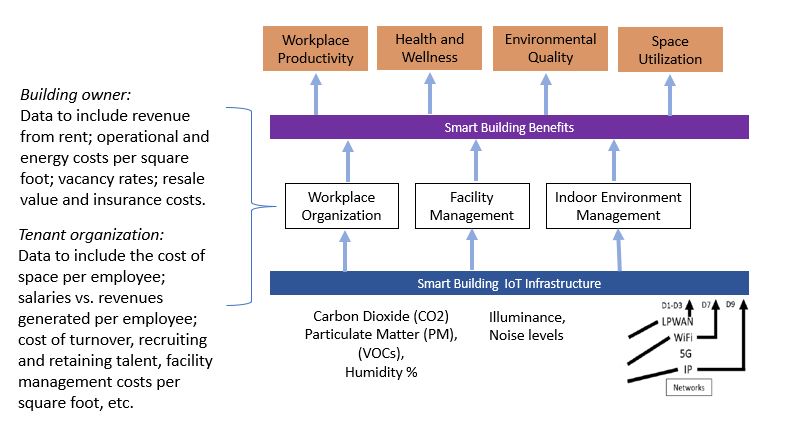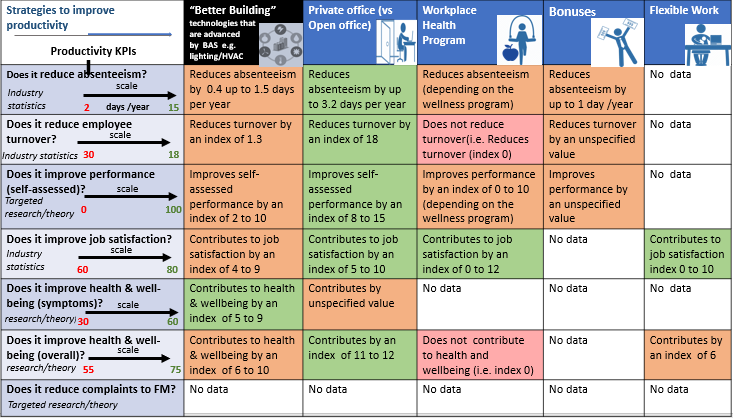Organizational and Individual Productivity and Wellness of Smart Buildings
| Smart Buildings | ||||||||||||||||||||||||||
|---|---|---|---|---|---|---|---|---|---|---|---|---|---|---|---|---|---|---|---|---|---|---|---|---|---|---|

| ||||||||||||||||||||||||||
| Sectors | Buildings Smart Buildings | |||||||||||||||||||||||||
| Contact | Jiri Skopek | |||||||||||||||||||||||||
| Topics | ||||||||||||||||||||||||||
Activities
Press
| ||||||||||||||||||||||||||
- Authors
This section explores the application of smart technologies in buildings to increase the ORGANIZATIONAL PRODUCTIVITY and WELLNESS of the various private/public sector stakeholders: the owners & investor organizations, property and facility management organizations, government and corporate tenants (i.e. organizations who occupy or rent space) and individual occupants.
The respective parts of the document consist of the following:
- The Benefits of Organizational and Individual Productivity and Wellness of Smart Buildings section identifies the productivity and health benefits of smart buildings to its occupants.
- The KPI section identifies the criteria by which Productivity and Wellness can be measured.
- Smart building technologies that will improve organizational productivity describe the various features and technologies further addressed in detail in the section.
- Finally Case studies section provides examples of the GECB implementation.
Benefits of Organizational and Individual Productivity and Wellness
In the post-COVID era, the commercial real estate (CRE) sector is facing several key problems and challenges:
- Reduced demand: The pandemic has disrupted various industries, leading to downsizing, closures, and work-from-home arrangements. This has resulted in reduced demand for office spaces, retail spaces, and other commercial properties. The shift towards remote work and e-commerce has impacted the need for physical space particularly in offices.
- Office space utilization: Many organizations have realized the effectiveness of remote work and adopted flexible work policies. As a result, companies are reassessing their office space requirements, leading to a potential oversupply of office spaces. This has put downward pressure on rental rates and occupancy levels.
- Repurposing and adaptive reuse: As traditional demand for certain types of commercial real estate declines, there is a need for creative solutions such as repurposing and adaptive reuse. Finding new uses for vacant or underutilized spaces, such as converting office buildings into residential or mixed-use developments, poses both challenges and opportunities.
- Health and safety concerns: The pandemic has raised concerns about health and safety in commercial properties. There is a greater focus on ventilation systems, touchless technologies, and sanitation practices to ensure the well-being of occupants. Implementing these measures can involve additional costs for property owners.
It's important to note that the specific challenges and their extent can vary across different regions, property types, and market conditions. While these problems pose significant obstacles, they also present opportunities for innovation, adaptation, and the reimagining of commercial real estate in the post-COVID era.
Here are some of the benefits of smart buildings on organizational and individual productivity and wellness:
- Workplace Productivity: Smart buildings can significantly support employee productivity, which can be linked to organizational engagement and well-being. Smart buildings can create meaningful customer interactions, enhancing the overall experience for visitors and employees alike.[1]
- Health and Wellness: Smart buildings can optimize the wellness of indoor environments. Focusing on employee wellness is a sound business decision. This is because a comfortable and healthy working environment can improve employee satisfaction and lead to happier and more productive employees.[2]
- Better Environmental Quality: This includes improved indoor air quality, air filtration, lighting, water quality, and more, which directly impacts the health and well-being of occupants.[3]
- Space Utilization: Smart buildings can optimize space utilization, ensuring that the available space is used efficiently. This can lead to cost savings and improved productivity.[4]

Figure 1: Relationship of the three H-KPI levels of the Productive and Wellness Buildings ( In the web version clicking on the particular component of the diagram will take you to the relevant text section)center;
Definitions & KPIs of organizational and workplace productivity
Organizational Productivity: The National Library of Medicine defines "organizational productivity" as: The capacity of an organization, institution, or business to produce desired results with a minimum expenditure of energy, time, money, personnel, material.[5]
Simply put, it is a measure of how effectively an organization uses its resources to achieve its goals.
Organizational productivity is generally measured using a basket of metrics, sometimes measured in different units. These will vary depending on the type of organization. For a building owner’s organization, the basket of metrics could include revenue from rent; operational and energy costs per square foot; vacancy rates; resale value and insurance costs. For a tenant organization, the basket might include: the cost of space per employee; salaries vs. revenues generated per employee; cost of turnover, recruiting and retaining talent, facility management costs per square foot and so forth. It is by factoring all these metrics, that organizations determine their overall balance of costs and revenues.[6]
Workplace productivity is just one element of organizational productivity. It is defined as: The amount and quality of work accomplished in a work environment (for example, an office, a hospital or a restaurant) and how efficiently workers complete tasks at their workplaces.
Workplace productivity, like organizational productivity, is generally also measured using a basket of metrics, for example: the speed at which workers generate contracts and revenue; handle technical support calls for a tech firm; serve customers at a restaurant; produce a product at a factory; or come up with profitable innovations in addition to speed, the value of creative new ideas, problem resolution, and product designs. Keeping workplace productivity high helps an organization to reduce its costs, satisfy its stakeholders, expand its operations, and stand out in a competitive marketplace. By understanding common causes of low worker efficiency, it becomes possible to modify the workplace to streamline business processes and foster higher morale in the individuals that make up the workforce.
Workplace Productivity contributes to Organizational Productivity- Comparing the effect of various workplace strategies on worker productivity
A plethora of studies have demonstrated that the physical environment - that is to say, the form and function of the workplace – is a key determinant of workplace productivity, which, in turn leads to overall organizational productivity.
Like all organisms that thrive in their optimal environment, humans function better and our brains operate at their best in clean oxygenated air and certain thermal conditions of temperature, humidity and air movement. Just like every other species, humans need certain light conditions to trigger alertness and sleep and acoustic conditions that enable us to process information. We need hydration and nutrition and space to move. And we need to relax the body and periodically rest the mind[7]. For each of these physical factors, there are prescribed ranges under which the human body works better, and the brain operates at its best.
What are the indoor environmental quality KPIs?
Indoor Environmental Quality (IEQ) is a broad term that encompasses several different aspects of the built environment. Key Performance Indicators (KPIs) for Indoor Environmental Quality can cover several areas, including air quality, lighting, thermal comfort, acoustics, and ergonomics. The specific KPIs that are relevant can vary depending on the type of building and its occupants. Here are some of the key KPIs in each area:
1 Air Quality:
- Carbon Dioxide (CO2) Levels: High levels can cause discomfort and health issues. Recommended levels are usually below 1000 ppm (parts per million).
- Particulate Matter (PM): PM2.5 and PM10 are commonly used metrics. Lower numbers are better.
- Volatile Organic Compounds (VOCs): These should be minimized as they can cause health problems.
- Humidity: Ideal levels are usually between 30% and 60%.
- Radon: This naturally occurring radioactive gas can accumulate in buildings. The occurrence of radon varies with the site geology but is should be evaluated and minimized.
- Biophilic Design: Incorporating elements of nature into the built environment can contribute to IAQ and improve well-being.
2 Lighting:
- Illuminance Levels: Measured in lux, with recommended levels varying depending on tasks performed.
- Glare: Should be minimized to prevent visual discomfort.
- Daylight Availability: Encouraging the use of natural light can improve mood and performance.
- Lighting Control: Allowing occupants to control lighting can improve comfort and satisfaction.
3 Thermal Comfort:
- Temperature: Ideal levels depend on season, clothing, and personal preference, but generally between 68°F (20°C) and 78°F (25.5°C).
- Relative Humidity: Ideal levels are usually between 30% and 60%.
- Airflow: Good circulation can help maintain thermal comfort. Avoid drafts
4 Acoustics:
- Noise Levels: Measured in decibels (dB), with lower levels generally being more comfortable.
- Reverberation Time: A measure of echo in a space. A shorter reverberation time is usually better for speech intelligibility.
- Sound Insulation: High levels can reduce noise transmission between spaces.
5 Ergonomics:
- Furniture Design: Should support proper posture and reduce the risk of musculoskeletal problems.
- Layout: Should allow for easy movement and interaction with the space.
These physical environmental factors are observable and measurable, and their effect on brainpower output (productivity) has been well documented.[8]
Bad indoor air quality, thermal discomfort, noise and distractions, lack of daylight and poor visual ergonomics have a measurable negative effect on the productivity of individuals. For example, if we flush out carbon dioxide, and remove VOC pollutants from a workplace and in pump fresh air, – all else being equal, human brainpower improves measurably in terms of problem-solving, speed, and accuracy.[9]
That said, a common misunderstanding is that the physical workplace environment is the primary driver of employee engagement. Employee engagement results from the interaction of an employee’s response to both the culture and physical space, and the engagement level that results, though it can be predicted, is unique to the individual based on his/her ideal workplace characteristics. Engagement is an emotional response that is produced when people find their jobs meaningful and fulfilling, as well as when they feel they can do their best work. The emotional factors that are necessary for sustained employee engagement relate both to the work environment and to management style and the extent to which employees find, in their work: Meaning, Autonomy, personal Growth, recognition/Impact and human Connection — ‘MAGIC’.[10] Some of the most successful businesses of our time such as Apple, Microsoft or Amazon began as start-ups in cramped, uncomfortable workplaces.
Comparing the effect of various workplace strategies on worker productivity

Numerous studies have been done on the sorts of measures that are typically expected to improve productivity. The table (Figure 1) adapted from “Improving Organizational Productivity with Building Automation Systems” study[11] by the National Research Council (NRC) and CABA (Continental Association of Building Automation) summarizes the results. The study consisted of a broad review of national and international statistics and targeted studies on productivity in the workplace. The study attempted to tabulate the findings into a coherent framework that compares the benefits of various workplace strategies on worker productivity. One of the strategies that was compared relates to building features and operations”. Using the traffic light nomenclature, the areas in green represent the greatest positive effect; those in pink the least effective. The results show that there are indeed other factors than the physical workplace that affect productivity, such as privacy, wellness programs, flexible work and financial incentives.
The role of smart building technology to improve organizational productivity
Notwithstanding that there are many diverse aspects to the problem, there is no denying that smart building technologies are having a significant influence on the type of measures that organizations are adopting to improve their organizational productivity. For example, smart building technologies are affecting:
- the type of investments by Building Owners
- the way Property and Facility Managers operate buildings
- the strategies being employed by Government and Corporate Tenants to empower and accommodate their employees
- the interaction between Occupants and the workplace
Stakeholders
In office buildings, there are several private and public sector stakeholders whose decisions and behaviors will determine the level of productivity within their respective organizations. They include: i) Owners/Investors, ii) Property/Facility managers, iii) Public Sector or Commercial tenants; and iv) Occupants (i.e. individual occupants). Each stakeholder has a different perspective and expectations as well as different key performance indicators to measure their organization’s productivity. For example:
- For Owner/Investors/ Asset Managers (including Municipalities). Much of the real estate is owned by financial institutions and they want high value but low risk. They are interested in offering a building environment that attracts and retains tenants, drives high rental revenue and reduces operational costs and retains or increases resale value, but they are reluctant to invest in as-of-yet unproven solutions. However, whether they are in the public or private sector, they want to be leaders and will often invest in buildings that push the envelope, such as the Deloitte Edge in Amsterdam, which is currently the smartest building. There, organizational productivity can be a measure of return on investment.
- For Public Sector or Corporate organizations that are leasing or occupying buildings, the objective is to attract and retain the best talent and provide a frictionless, comfortable, healthy and productive working environment that will maximize the human capital (i.e. employee brainpower) by increasing work output. For some tenants, building data is now becoming part of the enterprise data management strategy. So, for example, the data building from sensors can be correlated with absenteeism, space occupancy and other HR data to provide indicators of productivity.
- For Property or Facility Managers it is a measure of the ability to operate the building with ease, efficiency and effectiveness to the satisfaction of the owner and the occupants.
- For individual tenants and occupants, it is a measure of the health, the potential for “flow” or highest-level work environment, comfort, professional amenities, work efficiency and human connection (professional and social) that the workplace offers.
How Smart Building Technologies Contribute to Organizational Productivity Goals[12]
Improving Organizational Productivity — The Business Case for Smart Building Technology
When it comes to cost savings and performance, smart building technology offers some of the best returns on investment, with as little as a one or two-year payback, through energy savings from heating, cooling and lighting, and through operational efficiencies as well as security and tracking of building space utilization. For example, smart building sensors and controls can optimize the use of elevators, detect water leaks, and alert a waste hauler to pick up waste only when a bin is full. While the evidence of the savings is still largely kept by the leading smart building providers as a ‘market advantage”, the ACEEE’s Buildings program offers 1.5 years project payback evidence in their study “Using Smart Technology to Save Energy in Existing Buildings”[13]
Smart buildings are part of the IoT revolution and digital transformation
The convergence of building science, big data analytics and IT telecommunications to produce ‘smart buildings’ is not a new concept. It is part of the same IoT revolution that improves organizational productivity of cities by solving congestion problems, enables global supply chains to deliver ‘just-in-time,’ and allows airlines to achieve powerful efficiency gains across large fleets of commercial jets. It is also a part of the digital transformation that organizations are undergoing in their approach to conducting business.
In real estate, the ‘Internet of Things’ (IoT) technology enables asset managers to operate entire portfolios of buildings from remote operations centers. There, they analyze ongoing data streams from sensors in the buildings, optimize each building’s use of energy, electricity and water, manage work orders, and dispatch mobile technicians to the buildings when needed. The technology to enable this competitive edge is already at hand, and the business case is compelling.
Increasingly the building data are becoming one of the inputs of the data management.
Smart Capabilities that contribute to organizational productivity for building stakeholders
TABLE A outlines how a SMART building can help to achieve the Organizational Productivity goals for each stakeholder organization and the SMART CAPABILITIES these may require.
| Stakeholder Organization | Organizational Productivity GOALS | Smart building CAPABILITIES to achieve the Organizational Productivity Goals |
| Owner/Investors | Produce savings and strong ROI from energy, operations and maintenance | SMART capabilities (criteria):
|
| Attract and retain tenants with services and amenities |
| |
| Future-proof the building by ensuring flexibility and resilience |
| |
| Property/Facility Managers | Produce savings and ROI to the satisfaction of the building owner from: energy, operations and maintenance | SMART capabilities (criteria):
|
| Provide a user-friendly interface with smart building technology in order to operate the building with ease, effectiveness, and efficiency |
| |
| Offer Health, comfort and wellness, thereby achieving occupant satisfaction and minimizing complaints |
| |
| Provides ease of communication with occupants |
| |
| Public Sector or Corporate Tenants | Maximize human capital, by attracting and retaining top talent | SMART capabilities (criteria):
|
| Produce operational savings |
| |
| Optimize space efficiency |
| |
| Drive productivity |
| |
| Ensure business continuity |
| |
| Produce operational savings |
| |
| Individual employees/occupants | Work efficiency (e.g. timesaving) | SMART capabilities (criteria):
|
| Safety |
| |
| Health, comfort and wellness |
| |
| Human connection (professional and social) | SMART capabilities (criteria):
|
Smart Technology Requirements to Achieve the Desired Capabilities
A SMART building needs the right technology and functionality to meet the Smart Building goals listed in Table A These can be broadly grouped in two areas:
- Operational Efficiency & ROI for the building owner and property managers. The technology typically consists of an analytical engine with a building that receives information, analyzes it and automatically adjusts controls through a building automation system (BAS) -i.e. a computer-based control system installed in buildings that controls and monitors the building's mechanical and electrical equipment such as ventilation, lighting, power systems, fire systems, and security systems. They are summarized in Tables B below.
- Organizational productivity for the public sector and corporate tenants and occupants, and a positive human experience of the occupants in the workplace. These are increasing the subject of development of Digital Assistants, which are all the “buzz” in Proptech. They are summarized in Tables C below.
| System | Operational Efficiencies | Examples |
| Smart energy management including monitoring, fault detection, analytics and diagnostics, and continuous commissioning | Smart Energy Analytics and Diagnostics aggregate and analyze building data to generate actionable insights that will save energy and cut costs. The programs address energy consumption and cost in three specific ways:
|
|
| Other smart energy features |
|
|
| Water efficiency and management features and controls/Smart bathroom |
|
|
| Waste |
|
|
| Asset Monitoring and Critical Asset tracking |
|
| System | WORKPLACE PRODUCTIVITY for the government and corporate tenants, and HUMAN EXPERIENCE of the occupants | Examples |
| Space utilization/people count |
It typically uses IR Utilization or Imagining Sensors |
|
| Wayfinding or presence detection in open-plan |
|
Serraview’s |
| Conference room scheduling/ resource booking |
|
|
| Temp/lighting/IAQ “smart” environmental control |
|
|
| Digital office management |
|
iOffice |
| Ergonomics |
|
|
| Engagement/Employee Interaction and Collaboration |
|
|
| Shared transportation, Smart parking | IoT has generated tremendous flexibility in transportation options from better usability of public transport, to bike sharing, ride sharing and smart parking * Ridesharing Apps offer on-demand hailing of vehicles. Some have the advantage of volume, while others offer better prices and superior technology.
|
Innovative Urban |
To deliver the capabilities effectively, the building should meet certain standards, discussed in other sections of this supercluster for:
- Communications and Connectivity
- Interface and Interoperability with Municipal Services
- Safety
- Transportation
How can smart building improve indoor air quality
Smart buildings, can be referred to as buildings integrated with IoT (Internet of Things) technology, can significantly enhance indoor air quality through several mechanisms. They can monitor, control, and optimize the building's environment, including the air quality, through real-time data analysis. Here are a few ways smart buildings can improve indoor air quality:
1. Advanced Sensors: Smart buildings can have integrated sensors that constantly monitor indoor air quality. These sensors can detect levels of carbon dioxide, volatile organic compounds, particulate matter, humidity, temperature, and more.
2. HVAC System Management: Smart buildings can optimize the Heating, Ventilation, and Air Conditioning (HVAC) system to enhance indoor air quality. The HVAC system can automatically adjust based on the data received from sensors. For example, if the carbon dioxide level rises above a certain threshold, the system can increase ventilation to bring in more fresh air.
3. Air Purification: Smart buildings can include advanced air purification systems that can remove pollutants and allergens from the air. The system can be triggered to activate based on sensor data, ensuring the air is always clean and safe.
4. Predictive Maintenance: Smart buildings can predict when HVAC equipment or air filters need maintenance or replacement before they fail or become less efficient. This ensures that the systems are always functioning optimally, contributing to better air quality.
5. Adaptive Ventilation: Smart buildings can optimize ventilation based on occupancy levels. For instance, if a room is crowded, the system could increase ventilation to ensure proper air exchange.
6. Real-Time Alerts: In case of an unexpected event that affects air quality (e.g., a fire or a gas leak), the smart building's system can send real-time alerts to the building management and occupants, ensuring swift action can be taken.
7. Integration with Outdoor Air Quality Data: Smart buildings can also integrate real-time outdoor air quality data to modulate indoor air quality. If the outdoor air quality is poor, for instance, due to smog, the building can automatically limit intake of outdoor air and rely more on air purification systems.
8. Personalization: Some smart buildings can allow occupants to set their preferences for temperature, humidity, etc., which can positively affect perceived air quality.
There are examples of smart buildings improving indoor air quality. For example, natural ventilation can improve indoor air quality by reducing pollutants that are indoors. Examples of natural ventilation are opening windows and doors and window shading such as closing the blinds.
Smart buildings can also improve indoor air quality by using indoor air quality sensors that are part of the HVAC (heating, ventilation and air conditioning) control system. These sensors can detect the level of pollutants in the air and adjust the ventilation system accordingly.
Another way smart buildings can improve indoor air quality is by using ultraviolet (UV) lights and air purifiers. UV lights can kill bacteria and viruses in the air while air purifiers can remove pollutants such as dust, pollen, and smoke.
Case Studies
Smart, Healthy and Productive buildings provide value and attract tenants. Some examples of such buildings include:
The Edge, Amsterdam The Edge was called ‘the smartest building in the world’ in 2015. Home to one of Deloitte’s headquarters, it has a BREEAM sustainability score of 98.4%, is packed with 28,000 sensors, and even has an app where each employee can adjust their light and temperature preferences.
Apple Park, Cupertino Apple Park is one of the most modern and environmentally friendly offices in the world]. The building subscribe to the ethos of a democratic, non-hierarchical culture where information can be easily shared. Workers sit in clusters by department in a wide variety of office types. The natural ventilation promote good indoor air quality. During the 3 months that the building needs to be heated, it is done using solar energy and biofuels . It has an interior forest with about 9,000 drought-resistant trees, for the use of employees.
Bloomberg European Headquarters, St. Paul’s, London Bloomberg’s HQ is a great example of using smart tech to hit sustainability goals. With a BREEAM sustainability rating of 98.5%, the office takes a comprehensive approach to improving employee wellbeing while minimizing its environmental impact. Sensors monitor occupancy movement throughout the building and adjust airflow in line with these levels, saving ‘600-750 MWh of power per year’. An on-site water treatment plant, recycled water system and vacuum-flush toilets massively reduce wasted water – the building is 70% more water-efficient than the average office.
Medibank Place , Melbourne In Medibank Place architects wanted to create the healthiest workplace in the world. The workplace itself has been designed to promote healthy living in all its dimensions: physical, emotional and social. The plan encourages movement through the office and between floors to maximize the physical activity of staff. Based on a brief written by Dutch activity-based working specialists Veldhoen and Company, the workspace is designed for activity-based work. Four “neighbourhoods” are distributed along the linear floor plate, each beginning with an identifiable “home base”.
SalesForce Tower, San Francisco Salesforce is challenging occupants’ wellbeing to it’s core. Staying healthy not just through it’s inhouse yoga sessions, relaxation areas, but also giving employees the opportunity to not always take the lift. SalesForce Tower in San Francisco makes great use of smart tech. It combines digital twins with a smart HVAC system and water recycling to reduce energy consumption, cut down water wastage and provide better understanding of space utilization.
- ↑ Cisco Smart Building Solutions https://www.cisco.com/c/en/us/solutions/smart-building.html#~benefits
- ↑ 28 Surefire Ways To Boost Employee Wellbeing In 2023 https://snacknation.com/blog/employee-wellbeing
- ↑ Skopek S., SMART Green + Productive Workplace: A Practical Desk Companion for Corporate Real Estate Professionals https://www.amazon.ca/SMART-Green-Productive-Workplace-Professionals-ebook/dp/B07BF6KB8X
- ↑ The ProTech Guide to Smart Buildings https://www.metrikus.io/blog/ultimate-guide-smart-buildings
- ↑ Harvard Catalyst, Efficiency, Organizational https://connects.catalyst.harvard.edu/Profiles/display/Concept/Efficiency,%20Organizational
- ↑ Defining and measuring productivity in the public sector: Managerial perceptions, July 2010, International Journal of Public Sector Management 23(5):479-499 https://www.researchgate.net/publication/235317696_Defining_and_measuring_productivity_in_the_public_sector_Managerial_perceptions
- ↑ GCA, Sustainable Facilities Tool: Building and Health at https://sftool.gov/learn/about/576/buildings- health#building-design
- ↑ Skopek S., SMART Green + Productive Workplace: A Practical Desk Companion for Corporate Real Estate Professionals https://www.amazon.ca/SMART-Green-Productive-Workplace-Professionals-ebook/dp/B07BF6KB8X
- ↑ Allen, J., Building evidence for health: Ventilation, Harvard School of Public Health. Available at: http://forhealth.org/Harvard.Building_Evidence_for_Health.the_9_Foundations.pdf
- ↑ Rogel C., MAGIC: The five keys of employee engagement, Decisionwise, https://www.decision-wise.com/5-keys- of-employee-engagement-magic/
- ↑ CABA, National Research Council of Canada, Improving Organizational Productivity with Building Automation Systems, 2017
- ↑ Skopek S.,2017, SMART Green + Productive Workplace – A desk companion for corporate real estate professionals, (Chapter 26), JLL
- ↑ Jennifer King and Christopher Perry “Using Smart Technology to Save Energy in Existing Buildings” ACEEE Report A1701, February 2017







